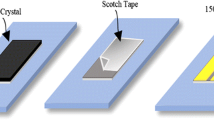Abstract
In this paper, vanadium oxide thin film of TCR of −3.5%/K has been deposited by pulsed DC magnetron sputtering method. The property of this VO x has been investigated by X-ray diffractometer (XRD) and atomic force microscopy (AFM) in detail. XRD test indicates that this film is composed of V2O3, V3O5 and VO2.VO x microbolometer with infrared (IR) absorbing structure is fabricated based on porous silicon sacrificial layer technology. Optimized micro-bridge structure is designed and carried out to decrease thermal conductance and this structure shows good compatibility with micromachining technology. This kind of bolometer with 74% IR absorption of 8–14 μm, has maximum detectivity of 1.09×109 cm·Hz1/2/W at 24 Hz frequency and 9.8 μA bias current.
Similar content being viewed by others
References
Gu X, Karunasiri G, Chen G, Sridhar U, Xu B. Determination of thermal parameters of microbolometers using a single electrical measurement. Applied Physics Letters, 1998, 72(15): 1881–1883
Niklaus F, Vieider C, Jakobsen H. MEMS-based uncooled infrared bolometer arrays-a review. Proceedings of SPIE, 2007, 6836, 68360D1–6836D15
Mottin E, Martin J L, Ouvrier-Buffet J L, Vilain M, Bain A, Yon J J, Tissot J L, Chatard J P. Enhanced amorphous silicon technology for 320×240 microbolometer arrays with a pitch of 35 μm. Proceedings of SPIE, 2001, 4369: 250–256
Kosasayama Y, Sugino T, Nakaki Y, Fujii Y, Inoue H, Yagi H, Hata H, Ueno M, Takeda M, Kimata M. Pixel scaling for SOI-diode uncooled infrared focal plane arrays. Proceedings of SPIE, 2004, 5406: 504–511
Wallner J Z, Bergstrom P L. A porous silicon based particle filter for microsystems. Physica Status Solidi (a), 2007, 204(5): 1469–1473
Tsamis C, Tserepi A, Nassiopoulou A G. Fabrication of suspended porous silicon micro-hotplates for thermal sensor applications. Physica Status Solidi (a), 2003, 197(2): 539–543
Lysenko V, Perichon S, Remaki B, Barbier D. Thermal isolation in microsystems with porous silicon. Sensors and Actuators A: Physical, 2002, 99(1–2): 13–24
Steiner P, Richter A, Lang W. Using porous silicon as a sacrificial layer. Journal of Micromechanics and Microengineering, 1993, 3(1): 32–36
Searson P C. Porous silicon membranes. Applied Physics Letters, 1991, 59(7): 832–833
Kishino K, Unlu M S, Chyi J I, Reed J, Arsenault L, Morkoc H. Resonant cavity enhanced photodetectors. IEEE Journal of Quantum Electron, 1991, 27(8): 2025–2034
Wang H C, Yi X J, Huang G, Xiao J, Li X W, Chen S H. IR microbolometer with self-supporting structure operating. Infrared Physics & Technology, 2004, 45(1): 53–57
Author information
Authors and Affiliations
Corresponding author
Rights and permissions
About this article
Cite this article
Wang, B., Lai, J., Zhao, E. et al. Research on VO x uncooled infrared bolometer based on porous silicon. Front. Optoelectron. 5, 292–297 (2012). https://doi.org/10.1007/s12200-012-0224-7
Received:
Accepted:
Published:
Issue Date:
DOI: https://doi.org/10.1007/s12200-012-0224-7




